Explore different types of water towers (gravity, elevated, hydropneumatic) & their materials (steel, concrete, even wood! Ever regarded up and seen a towering form, corresponding to a massive mushroom or a spindly metal skyscraper, dominating the skyline? That, my buddy, is a water tower, and there are extra sorts of water towers than you could suppose! These silent sentinels play a critical position in ensuring a normal and steady go with the flow of water to our houses and groups. Let’s delve into the charming international of water towers and discover the specific hats they put on!
Table of Contents
Different Types of Water Towers
Water towers are to be had all patterns and sizes, however their center feature boils down to one element: maintaining constant water pressure. Here’s a breakdown of the extremely good kinds of water towers primarily based on how they collect this:
- Gravity Tanks: The Classic Guardians of Pressure: These are the granddaddies of water towers, often comparable to big, accelerated garage tanks. They depend on gravity to create pressure. Imagine a huge bucket full of water – the higher the bucket, the more potent the pressure of the water flowing out. Gravity tanks are typically positioned on hills or stepped forward structures, ensuring constant pressure in some unspecified time in the future of a network, especially in regions with fluctuating water desires.
- Elevated Tanks: Reaching New Heights for Water Distribution: As the call suggests, those types of water towers are expanded structures, regularly supported by means of manner of a unmarried or multiple legs. They function at the equal principle as gravity tanks, but via attaining higher elevations, they are capable of offer more pressure and serve a far wider region. Imagine a skyscraper full of water – it could deliver water with even greater pressure! Elevated tanks are a commonplace sight in city and suburban regions.
- Hydropneumatic Tanks: Blending Air and Water for Pressure Stability: These present day styles of water towers use a combination of air and water to keep stress. A pressurized air bladder sits inside the tank, pushing down on the water and developing steady stress. Imagine a balloon pushing down on water in a closed area – it’s far the essential concept! Hydropneumatic tanks are regularly utilized in smaller communities or to complement pressure in present structures, supplying a place-saving and inexperienced solution.
Names of Different Types of Water Towers
The materials used to construct water towers not handiest impact their aesthetics but moreover their sturdiness and normal overall performance. Here’s a have a study the not unusual types of water towers based on their creation substances:
- Steel Water Towers: Strength and Durability for Modern Needs: These are the workhorses of the water tower international. Steel gives superb strength and might face up to harsh climate situations. The smooth, present day appearance of metal water towers makes them a familiar sight in lots of city landscapes.
- Concrete Water Towers: A Timeless Option for Stability: Concrete water towers are recognized for their wonderful sturdiness and resistance to corrosion. They provide a strong and solid alternative, frequently built in a cylindrical or square shape. While not as visually putting as metal towers, concrete gives a cost-effective and reliable answer for plenty organizations.
- Wooden Water Towers: A Glimpse into History: These charming giants are a nostalgic reminder of the past. While no longer as common these days due to protection and safety issues, some ancient wooden water towers though stand as testaments to early engineering ingenuity.

Beyond the Basics: A Celebration of Design
Types of water towers are not pretty a good deal feature! Throughout history, water towers have evolved from simply utilitarian structures to architectural landmarks. From the ornate designs of Chicago’s standpipe towers to the futuristic shapes of Dubai’s water reservoirs, water towers display off the creative integration of shape and characteristic
The Future of Water Towers: Innovation and Sustainability
As technology advances, the design and operation of forms of water towers are constantly evolving. New materials like composite fiberglass offer lightweight, long lasting options. Smart generation lets in for faraway tracking and optimization of water stress and stages. Additionally, water towers are being explored for their capacity to combine with renewable energy assets, together with using solar panels on their roofs to energy their operations.
Fun Facts: Interesting Trivia About Water Towers
Did you recognize that the arena’s biggest water tower can preserve a marvelous 3.6 million gallons of water? Or that a few water towers are cleverly disguised as houses or perhaps giant pineapples? The global of water towers is full of charming trivialities waiting to be found!
Call to Action:
Now which you’re armed with understanding approximately the awesome types of water towers, positioned your newfound expertise to the take a look at! The next time you are out and approximately, see if you may spot a water tower. Notice its format, try to understand its characteristic primarily based mostly on its form and location, and respect the silent role it plays in making sure a regular drift of water in your network.
